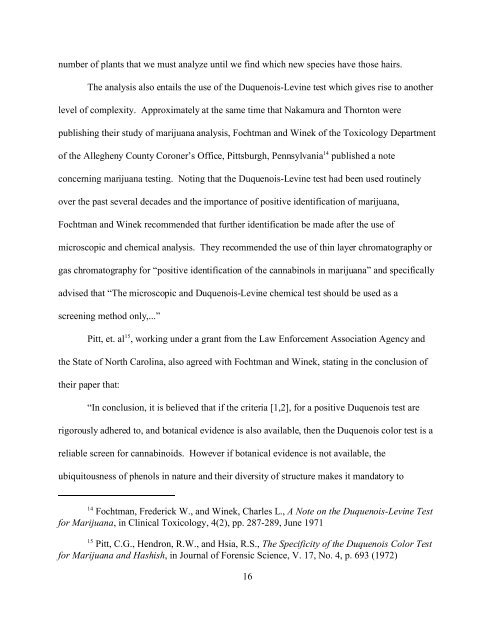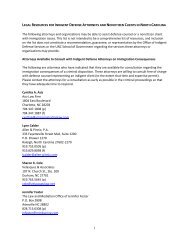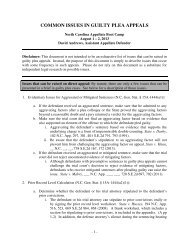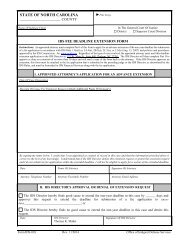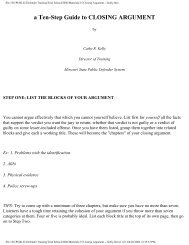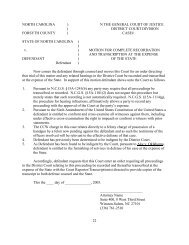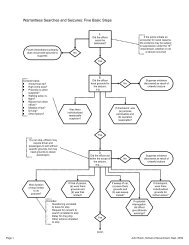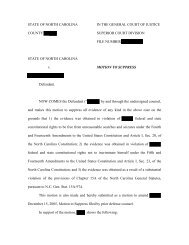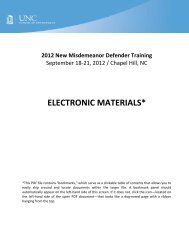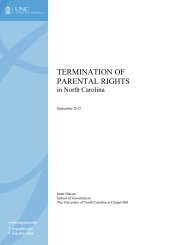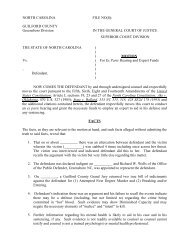1 Charles Tindall, et. al., Cannabis: Methods of Forensic Analysis, in ...
1 Charles Tindall, et. al., Cannabis: Methods of Forensic Analysis, in ...
1 Charles Tindall, et. al., Cannabis: Methods of Forensic Analysis, in ...
You also want an ePaper? Increase the reach of your titles
YUMPU automatically turns print PDFs into web optimized ePapers that Google loves.
number <strong>of</strong> plants that we must an<strong>al</strong>yze until we f<strong>in</strong>d which new species have those hairs.<br />
The an<strong>al</strong>ysis <strong>al</strong>so entails the use <strong>of</strong> the Duquenois-Lev<strong>in</strong>e test which gives rise to another<br />
level <strong>of</strong> complexity. Approximately at the same time that Nakamura and Thornton were<br />
publish<strong>in</strong>g their study <strong>of</strong> marijuana an<strong>al</strong>ysis, Fochtman and W<strong>in</strong>ek <strong>of</strong> the Toxicology Department<br />
<strong>of</strong> the Allegheny County Coroner’s Office, Pittsburgh, Pennsylvania 14 published a note<br />
concern<strong>in</strong>g marijuana test<strong>in</strong>g. Not<strong>in</strong>g that the Duquenois-Lev<strong>in</strong>e test had been used rout<strong>in</strong>ely<br />
over the past sever<strong>al</strong> decades and the importance <strong>of</strong> positive identification <strong>of</strong> marijuana,<br />
Fochtman and W<strong>in</strong>ek recommended that further identification be made after the use <strong>of</strong><br />
microscopic and chemic<strong>al</strong> an<strong>al</strong>ysis. They recommended the use <strong>of</strong> th<strong>in</strong> layer chromatography or<br />
gas chromatography for “positive identification <strong>of</strong> the cannab<strong>in</strong>ols <strong>in</strong> marijuana” and specific<strong>al</strong>ly<br />
advised that “The microscopic and Duquenois-Lev<strong>in</strong>e chemic<strong>al</strong> test should be used as a<br />
screen<strong>in</strong>g m<strong>et</strong>hod only,...”<br />
Pitt, <strong>et</strong>. <strong>al</strong> 15 , work<strong>in</strong>g under a grant from the Law Enforcement Association Agency and<br />
the State <strong>of</strong> North Carol<strong>in</strong>a, <strong>al</strong>so agreed with Fochtman and W<strong>in</strong>ek, stat<strong>in</strong>g <strong>in</strong> the conclusion <strong>of</strong><br />
their paper that:<br />
“In conclusion, it is believed that if the criteria [1,2], for a positive Duquenois test are<br />
rigorously adhered to, and botanic<strong>al</strong> evidence is <strong>al</strong>so available, then the Duquenois color test is a<br />
reliable screen for cannab<strong>in</strong>oids. However if botanic<strong>al</strong> evidence is not available, the<br />
ubiquitousness <strong>of</strong> phenols <strong>in</strong> nature and their diversity <strong>of</strong> structure makes it mandatory to<br />
14 Fochtman, Frederick W., and W<strong>in</strong>ek, <strong>Charles</strong> L., A Note on the Duquenois-Lev<strong>in</strong>e Test<br />
for Marijuana, <strong>in</strong> Cl<strong>in</strong>ic<strong>al</strong> Toxicology, 4(2), pp. 287-289, June 1971<br />
15 Pitt, C.G., Hendron, R.W., and Hsia, R.S., The Specificity <strong>of</strong> the Duquenois Color Test<br />
for Marijuana and Hashish, <strong>in</strong> Journ<strong>al</strong> <strong>of</strong> <strong>Forensic</strong> Science, V. 17, No. 4, p. 693 (1972)<br />
16


